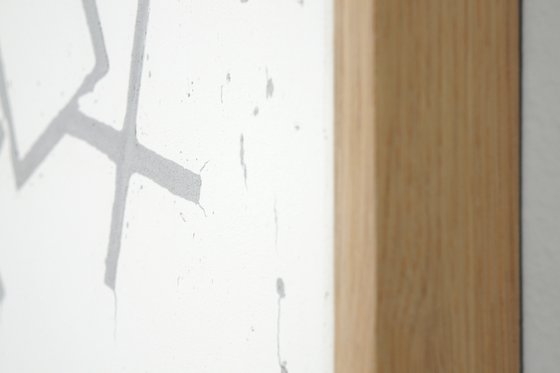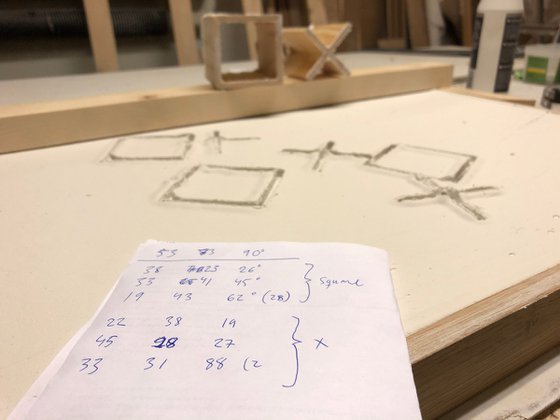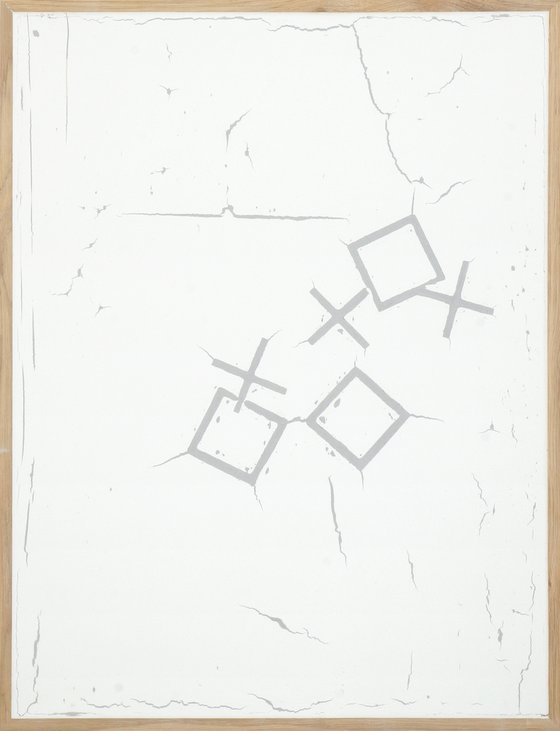- By medium
- By subject
- By budget
- Sales
- Gift cards
- Discover all art
- Artists
- Editors’ picks
- Ideas
Original artwork description:
64x84 cm | Filler, oak frame
The placement and direction of the x's and squares on the surface are made using a random number generator.
Personality tests are becoming more and more common in employment recruiting. You no longer want to know only the candidates' experience and skills, but also their individual characteristics. In psychology, such tests have long been a standard tool. There is also a great deal of public interest in taking simple, popularly designed variants themselves. The purpose of all these tests is to find out who the subject is. To see inside the shell. But instead of really trying to approach the subject's mystery, the eternal question - Who am I - the survey is dismissed with a simplified categorisation as the only result. One then misses the lesson about the function of language from psychoanalytic theory.
By stopping the introspection of the subject at the level of simple categorisation, the investigation semantically does not move out of the Imaginary field. Even if you fill the different categories with descriptions, their primary objective is a simple differentiation. That is, it matters less how they are described than what function they perform. The purpose is to sort, not to explain. For a semantic act to become real in a psychoanalytic sense, i.e. that it should give meaning to the subject on a deeper level, it must be put into practice. It must be given a physical material form. The materialisation of language in the physical always adds something unexpected and elusive. The encounter with the Real gives pure language its entry into the Symbolic field. The act simultaneously creates an un-symbolised remnant that is primordial to desire. Without this subtle dislocation within language, it becomes lifeless and empty, the description misses the very kernel of what it wishes to describe.
The economisation of language serves the purposes of neoliberalism. But the unresolved suspension in the Imaginary is an immature understanding of the subject's position. Only by taking into account the chaotic and boundless nature of physical material reality can a more profound understanding be achieved.
Tick Boxes
This is a series of works that use squares and crosses as compositional elements. The very components that constitute so-called checkboxes on questionnaires with prepared answer options. It is a tool for different types of surveys and application forms—systems for sorting people into different categories, and for maintaining various types of boundaries and constraints.
They are an essential part of an expanding neoliberal organisational culture where measurable results are crucial. Efforts are analysed against predetermined standards to increase economic efficiency. Language is trimmed for aesthetic qualities in favour of a strictly rational understanding. These works want to illuminate and challenge this trend by deconstructing one of its primary forms.
Materials used:
Filler (coarse and fine) in oak frame
Tags:
#abstract #painting #minimalism #oak frame #filler#303 Personality Test (Random Version) (2020)
Painting
by Johan Söderström
1 Artist Reviews
£1,029.66
- Painting on Panel / Board / MDF
- One of a kind artwork
- Size: 64 x 84 x 5cm (framed)
- Framed and ready to hang
- Signed on the back
- Style: Geometric
- Subject: Abstract and non-figurative
Original artwork description
64x84 cm | Filler, oak frame
The placement and direction of the x's and squares on the surface are made using a random number generator.
Personality tests are becoming more and more common in employment recruiting. You no longer want to know only the candidates' experience and skills, but also their individual characteristics. In psychology, such tests have long been a standard tool. There is also a great deal of public interest in taking simple, popularly designed variants themselves. The purpose of all these tests is to find out who the subject is. To see inside the shell. But instead of really trying to approach the subject's mystery, the eternal question - Who am I - the survey is dismissed with a simplified categorisation as the only result. One then misses the lesson about the function of language from psychoanalytic theory.
By stopping the introspection of the subject at the level of simple categorisation, the investigation semantically does not move out of the Imaginary field. Even if you fill the different categories with descriptions, their primary objective is a simple differentiation. That is, it matters less how they are described than what function they perform. The purpose is to sort, not to explain. For a semantic act to become real in a psychoanalytic sense, i.e. that it should give meaning to the subject on a deeper level, it must be put into practice. It must be given a physical material form. The materialisation of language in the physical always adds something unexpected and elusive. The encounter with the Real gives pure language its entry into the Symbolic field. The act simultaneously creates an un-symbolised remnant that is primordial to desire. Without this subtle dislocation within language, it becomes lifeless and empty, the description misses the very kernel of what it wishes to describe.
The economisation of language serves the purposes of neoliberalism. But the unresolved suspension in the Imaginary is an immature understanding of the subject's position. Only by taking into account the chaotic and boundless nature of physical material reality can a more profound understanding be achieved.
Tick Boxes
This is a series of works that use squares and crosses as compositional elements. The very components that constitute so-called checkboxes on questionnaires with prepared answer options. It is a tool for different types of surveys and application forms—systems for sorting people into different categories, and for maintaining various types of boundaries and constraints.
They are an essential part of an expanding neoliberal organisational culture where measurable results are crucial. Efforts are analysed against predetermined standards to increase economic efficiency. Language is trimmed for aesthetic qualities in favour of a strictly rational understanding. These works want to illuminate and challenge this trend by deconstructing one of its primary forms.
Materials used:
Filler (coarse and fine) in oak frame
Tags:
#abstract #painting #minimalism #oak frame #fillerReturns and refunds
We want you to love your art! If you are not completely satisfied with your purchase you can return it free within 14 days, no questions asked. Learn more
Artist Reviews (1)
This artwork is sold by Johan Söderström from Norway








